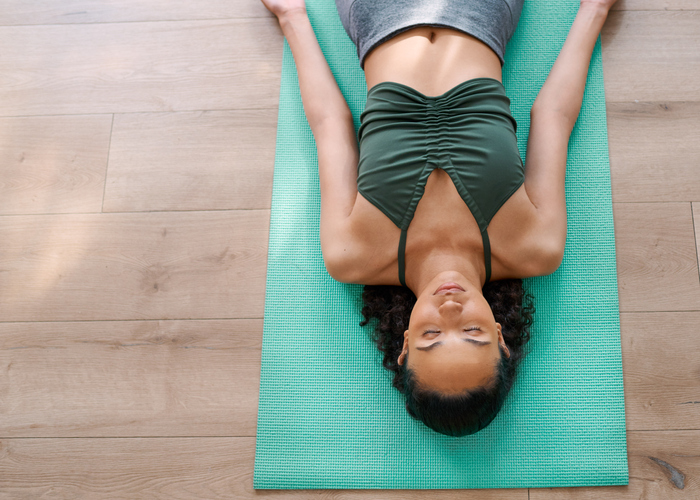Want to crush it at the gym, in the office, and at home? Start with a good night’s sleep. Rest is crucial for overall health and well-being at all stages of life. With one in three adults reporting “poor” or “fair” sleep, many are exploring yoga nidra to have more restful nights.
Having been recorded as far back as the 7th century AD, “yogic sleep” has plenty of benefits — like potentially better rest, stress management, and a healthy mood. But “yoga nidra is not a substitute for sleep,” says yoga nidra instructor Karen Brody.
It’s also not yoga. “Yoga nidra is a sleep-based meditation practice and a form of awareness,” she explains.
Read on to learn about guided meditation for sleep, how to get started, what it can do for you — and why you still need at least seven hours of shuteye.
What Is Yoga Nidra?
Yoga nidra is a yogic meditation practice whose goal is a balance between relaxation and awareness that brings you to the third of four levels of consciousness. In the context of sleep, this is the deepest stage of non-REM (rapid eye movement) sleep.
“Yoga nidra is a technique to access a state of deep relaxation for both the mind and body, where consciousness remains awake and aware,” says Tracee Stanley, author of Radiant Rest: Yoga Nidra for Deep Relaxation and Awakened Clarity and a yoga nidra facilitator and practitioner for over 20 years.
In a typical yoga nidra practice, you lie on your back in savasana while an instructor guides you through a visualization designed to keep you hovering between sleep and wakefulness. While you might drift off, that’s not the goal.
“The biggest misconception is that yoga nidra is a yoga nap,” adds Stanley. “During sleep, you are not aware. You do not remember what happened when you were asleep. In the state of yoga nidra, you remain conscious in the liminal spaces between sleep and wakefulness.”
How Does Yoga Nidra Work?
Yoga nidra helps you slow down and relax, shifting your body into “rest and digest” mode and turning on the parasympathetic nervous system.
The practice shifts you into “a peaceful and blissful state known as samadhi,” Stanley says. “Yoga nidra is the nurturing aspect of nature that welcomes repose, rest, and being held unconditionally,” she explains.
That sounds, well, blissful, but does yoga nidra really work? Research has confirmed significant differences in delta brain waves after only two weeks of a yoga nidra practice. Delta waves are associated with the deepest levels of relaxation.
We’ll dive into other benefits later on.
But as for claims that yoga nidra can offset a poor night’s sleep or somehow replace sleep? No way, says psychotherapist Niloufar Esmaeilpour, who holds a master’s in clinical psychology.
“Assuming that practices like yoga nidra can replace sleep is risky because sleep involves critical biological processes, including cellular repair, toxin clearance from the brain, and memory consolidation, which cannot be replicated by meditation or relaxation techniques,” she says.
Brody adds, “it can help people who have sleep issues fall asleep or get back to sleep. A good night’s sleep takes you from waking to dreams to deep sleep.” Yoga nidra does all that and takes you into a “state of consciousness that cannot be accessed by conventional sleep.”
How Does Yoga Nidra Differ From Meditation?
While both yoga nidra and meditation offer guided routes to relaxation, they differ in a number of ways. For starters, you’re typically seated during conventional meditation, while the customary body position for yoga nidra is corpse pose (savasana).
The two practices also emphasize different stages of consciousness. In meditation, “you either follow your breath or a mantra while you are awake,” Brody explains, unlike the sleep-wake-dream-bliss journey of yoga nidra, which reaches deeper levels of relaxation.
But it’s definitely not a competition: Both yoga nidra and meditation offer ample benefits for mind and body. And who couldn’t use some down time away from screens and work?
How to Do Yoga Nidra
Practicing yoga nidra for sleep is simple. You can find an in-person or online class, or download a yoga nidra meditation online. (BODi’s Sound Meditation program includes practices specifically for sleep.)
Find a comfortable spot to lie down — on a yoga mat, in bed, on the couch, or even in your car. If need be, you can even sit.
Once you’re comfy, turn on your guided meditation. You might want to cover your body with a blanket, put on an eye mask, and/or wear headphones. Then, tune out the real world as you tune in to yoga nidra. You can practice yoga nidra any time of day or night, and sessions can last from 15 minutes to an hour or more.
Yoga Nidra Benefits
Here are some of the science-backed benefits of yoga nidra:
1. A boost of mindfulness
Health workers experiencing both physical and mental exhaustion underwent an eight-week guided yoga nidra program and showed “significant improvement” in mindfulness.
2. Less stress, improved self-esteem
A group of university students was administered another eight-week yoga nidra regimen consisting of twice-weekly, one-hour sessions. The result was a significant decrease in stress intensity levels and increased self-esteem scores compared with a control group.
3. Better REM and non-REM sleep
Among patients with chronic insomnia who underwent a yoga nidra intervention, sleep quality and efficiency improved significantly, even when compared with cognitive behavioral therapy.
What’s not on the list of benefits? Swapping in yoga nidra for sleep, despite what you might see on social media. Make yoga nidra part of your relaxation routine — but be sure to prioritize the rest you deserve every night, too.


